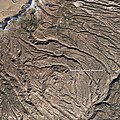File:Bandelier satphoto Winter 2015.jpg
Appearance

Size of this preview: 600 × 600 pixels. Other resolutions: 240 × 240 pixels | 480 × 480 pixels | 720 × 720 pixels.
Original file (720 × 720 pixels, file size: 338 KB, MIME type: image/jpeg)
File history
Click on a date/time to view the file as it appeared at that time.
| Date/Time | Thumbnail | Dimensions | User | Comment | |
|---|---|---|---|---|---|
| current | 06:01, 10 February 2016 |  | 720 × 720 (338 KB) | Tillman | {{Information |Description ={{en|1=On December 5, 2015, the Operational Land Imager (OLI) on Landsat 8 captured a natural-color image of Bandelier (top). The monument area encompasses about 130 square kilometers (50 square miles) of land west of San... |
File usage
The following page uses this file:


